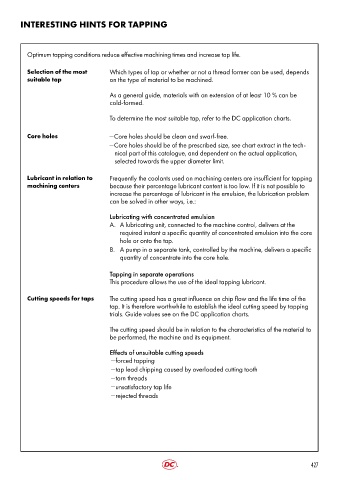Page 430 - DC_SWISS(Catalogue_TM_ES-EN)
P. 430
INTERESTING HINTS FOR TAPPING
Optimum tapping conditions reduce effective machining times and increase tap life.
Selection of the most Which types of tap or whether or not a thread former can be used, depends
suitable tap on the type of material to be machined.
As a general guide, materials with an extension of at least 10 % can be
cold-formed.
To determine the most suitable tap, refer to the DC application charts.
Core holes Core holes should be clean and swarf-free.
Core holes should be of the prescribed size, see chart extract in the tech-
nical part of this catalogue, and dependent on the actual application,
selected towards the upper diameter limit.
Lubricant in relation to Frequently the coolants used on machining centers are insufficient for tapping
machining centers because their percentage lubricant content is too low. If it is not possible to
increase the percentage of lubricant in the emulsion, the lubrication problem
can be solved in other ways, i.e.:
Lubricating with concentrated emulsion
A. A lubricating unit, connected to the machine control, delivers at the
required instant a specific quantity of concentrated emulsion into the core
hole or onto the tap.
B. A pump in a separate tank, controlled by the machine, delivers a specific
quantity of concentrate into the core hole.
Tapping in separate operations
This procedure allows the use of the ideal tapping lubricant.
Cutting speeds for taps The cutting speed has a great influence on chip flow and the life time of the
tap. It is therefore worthwhile to establish the ideal cutting speed by tapping
trials. Guide values see on the DC application charts.
The cutting speed should be in relation to the characteristics of the material to
be performed, the machine and its equipment.
Effects of unsuitable cutting speeds
forced tapping
tap lead chipping caused by overloaded cutting tooth
torn threads
unsatisfactory tap life
rejected threads
427

